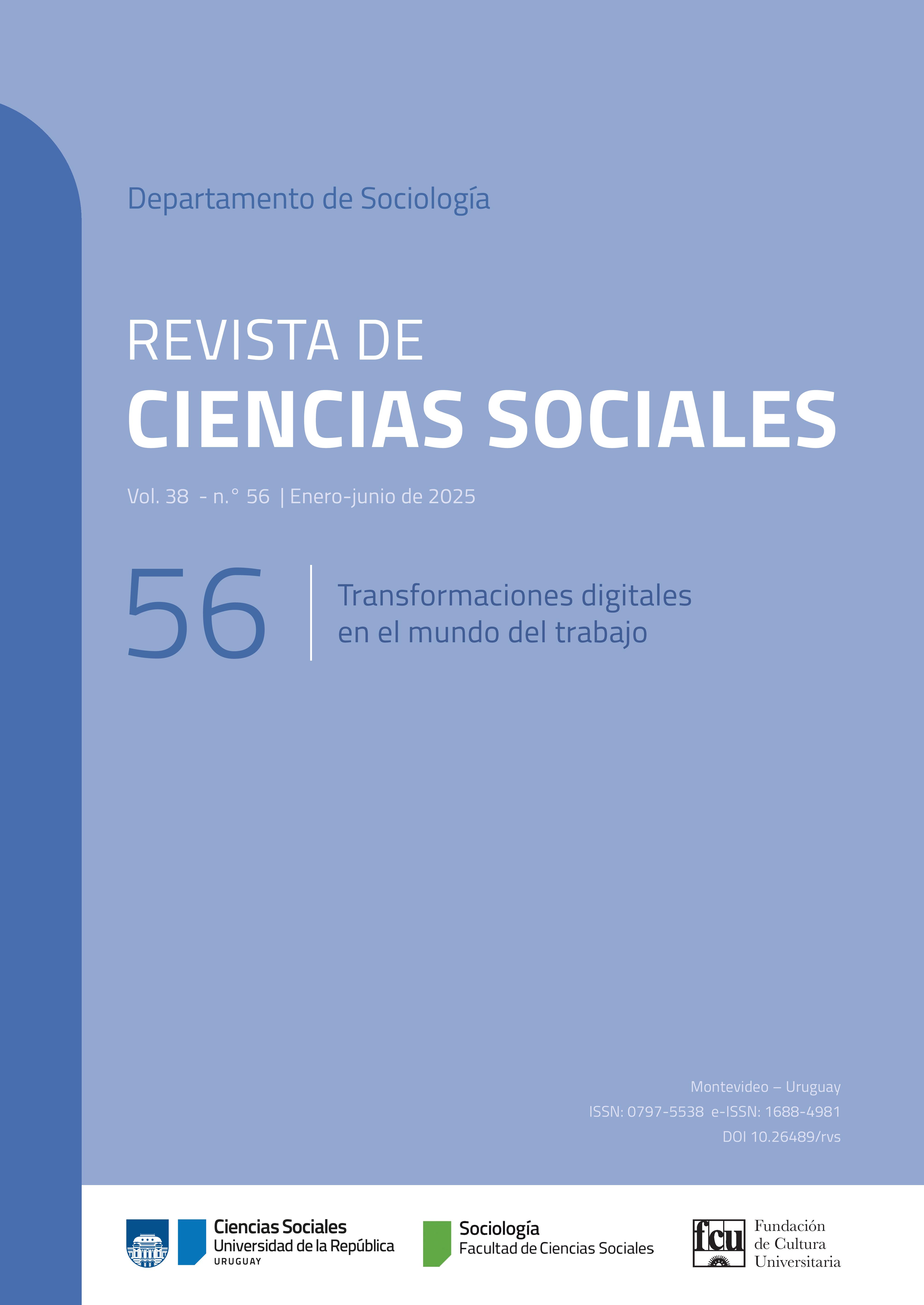Intimate femicide-suicides
Contributions to their causal explanation based on a reinterpretation of research on homicide-suicides
DOI:
https://doi.org/10.26489/rvs.v38i56.5Keywords:
femicide, suicide, intimate partner, theory, criminologyAbstract
Based on a systematization of research on homicides followed by the perpetrator’s suicide, this article reviews the main theories used by criminological literature to explain intimate partner homicides towards women where the perpetrator commits suicide. Although not originating from academic feminism, these contributions identify control, sexual ownership, and the construction of masculinity as central analytical categories. Therefore, they develop useful explanations for feminist research as they allow to conceptualize these incidents as intimate femicide-suicides and delve deeper into their causal mechanisms.
Downloads
References
Agnew, R. (1992). Foundation for a general strain theory of crime and delinquency. Criminology, 30, 47-87.
Agnew, R. (2004). A general strain theory approach to violence. En M. Zahn, H. Brownstein y S. Jackson (Eds.), Violence: From theory to research (37-54). Anderson.
Alexandri, M., Tsellou, M., Antoniou, A., Skliros, E., Koukoulis, A. N., Bacopoulou, F., Papadodima, S. (2022). Prevalence of homicide-suicide incidents in Greece over 13 years. International journal of environmental research and public health, 19(13), 7736.
Álvarez, M. (2018). Caracterización del fenómeno femicidio-suicidio en casos reportados en el Centro de Investigación de Ciencias Forenses Manabí 2014-2017. Universidad Central del Ecuador.
Balica, E., Stöckl, H. (2016). Homicide-suicides in Romania and the role of migration. European Journal of Criminology, 13(4), 517-534.
Baumgartner, M. P. (1984). Social control from below. En D. Black (Ed.), Toward a general theory of social control (vol. 1, 303-345). Academic Press.
Black, D. (1993). The social structure of right and wrong. Academic Press.
Black, D. (2004). Violent structures. En M. Zahn, H. Brownstein y S. Jackson (Eds.), Violence: From theory to research (145-158). Anderson.
Black, D. (2011). Moral time. Oxford University Press.
Bourget, D., Gagné, P., Whitehurst, L. (2010). Domestic homicide and homicide-suicide: The older offender. Journal of the American Academy of Psychiatry and the Law Online, 38(3), 305-311.
Campbell, J. C., Glass, N., Sharps. P. W., Laughon, K., Bloom, T. (2007). Intimate Partner Homicide: Review and Implications of Research and Policy. Trauma, Violence, & Abuse, 8(3), 246-269.
Cavan, R. (1928). Suicide. University of Chicago Press.
Dawson, M. (2005). Intimate femicide followed by suicide: Examining the role of premeditation. Suicide and Life-Threatening Behavior, 35(1), 76-90.
Dawson, M., Gartner, R. (1998). Differences in the characteristics of intimate femicides. Homicide Studies, 2(4), 378-399.
Dayan, H. (2021). Sociocultural aspects of femicide-suicide: The case of Israel. Journal of Interpersonal Violence, 36(9-10), NP5148-NP5166.
DeKeseredy, W. S., Schwartz, M. D. (2016). Thinking sociologically about image-based sexual abuse: The contribution of male peer support theory. Sexualization, Media, y Society, 2(4), 1-8.
DeKeseredy, W. S., Schwartz, M. D. (Eds.) (2013). Male peer support and violence against women: The history and verification of a theory. Northeastern University Press.
Densley, J. A., Hilal, S. M., Li, S. D., Tang, W. (2017). Homicide-suicide in China: An exploratory study of characteristics and types. Asian Journal of Criminology, 12, 199-216.
Dobash, R. E., Dobash, R. P. (2015). When men murder women. Oxford University Press.
Dobash, R. E., Dobash, R. P., Cavanagh, K., Medina-Ariza, J. (2007). Lethal and nonlethal violence against an intimate female partner: Comparing male murderers to nonlethal abusers. Violence Against Women, 13(4), 329-353.
Durkheim, É. (1992). El suicidio. Akal.
Echeburúa, E., Corral, P. D. (2009). El homicidio en la relación de pareja: un análisis psicológico. Eguzkilore: Cuaderno del Instituto Vasco de Criminología, 23, 139-150.
Ellis, D., Stuckless, N., Smith, C. (2015). Marital separation and lethal domestic violence. Elsevier.
Flynn, S., Swinson, N., While, D., Hunt, I. M., Roscoe, A., Rodway, C., Windfuhr, K., Kapur, N., Appleby, L., Shaw, J. (2009). Homicide followed by suicide: a cross-sectional study. The Journal of Forensic Psychiatry & Psychology, 20(2), 306-321. https://doi.org/10.1080/14789940802364369
Friedman, S. H., Hrouda, D. R., Holden, C. E., Noffsinger, S. G., Resnick, P. J. (2005). Filicide-suicide: Common factors in parents who kill their children and themselves. Journal of the American Academy of Psychiatry and the Law Online, 33(4), 496-504.
Gambetta, V. (2018). El femicidio íntimo en Uruguay. (Tesis de maestría). Universidad de la República. https://hdl.handle.net/20.500.12008/18989
Gambetta, V. (2022). Dificultades y desafíos para investigar el femicidio en Latinoamérica. Revista Latinoamericana de Metodología de las Ciencias Sociales, 12(2). https://doi.org/10.24215/18537863e115
Gillespie, M., Hearn, V., Silverman, R. A. (1998). Suicide following homicide in Canada. Homicide Studies, 2(1), 46-63.
Goode, W. J. (1971). Force and violence in the family. Journal of Marriage and the Family, 1971, 624-636.
Gregory, M. (2012). Masculinity and homicide-suicide. International Journal of Law, Crime and Justice, 40(3), 133-151.
Harper, D. W., Voigt, L. (2007). Homicide followed by suicide: An integrated theoretical perspective. Homicide Studies, 11(4), 295-318.
Johnson, H., Hotton, T. (2003). Losing control: Homicide risk in estranged and intact intimate relationships. Homicide Studies, 7(1), 58-84.
Kelly, J. B., Johnson, M. P. (2008). Differentiation among types of intimate partner violence: Research update and implications for interventions. Family Court Review, 46(3), 476-499.
Kennedy-Kollar, D., Charles, C. A. D. (2010). Hegemonic masculinity and mass murderers in the United States. Southwest Journal of Criminal Justice, 8(2), 62-74.
Lagarde, M. (2008). Antropología, feminismo, y política: violencia feminicida y derechos humanos de las mujeres. En B. Margaret y D. Mintegui (Coords.), Retos teóricos y nuevas prácticas (209-240). Ankulegi.
Lester, D. (2000). Murder-Suicide: A Review of the Recent Literature. Journal of the American Academy of Psychiatry and the Law Online, 28(3), 290-294.
Lester, D., Stack, A., Schmidtke, A., Schaller, S., Müller, I. (2005). Mass homicide and suicide: Deadliness and outcome. Crisis, 26(4), 184-187.
Liem, M. (2020). Familicide: The killing of spouse and children by men. En T. K. Shackelford (Ed.), The SAGE Handbook of Domestic Violence. SAGE. https://doi.org/10.4135/9781529742343
Liem, M., Nieuwbeerta, P. (2010). Homicide followed by suicide: a comparison with homicide and suicide. Suicide and Life-Threating Behavior, 40, 133-145.
Mailloux, S. (2014). Fatal families: Why children are killed in familicide occurrences. Journal of Family Violence, 29(8), 921-926.
Malphurs, J. E. y D. Cohen (2002). A newspaper surveillance study of homicide-suicide in the United States. The American Journal of Forensic Medicine and Pathology, 23(2), pp. 142-148.
Malphurs, J. E.; C. Eisdorfer y D. Cohen (2001). A comparison of antecedents of homicide-suicide and suicide in older married men. The American Journal of Geriatric Psychiatry, 9(1), 49-57.
Manning, J. (2012). Suicide as social control. Sociological Forum, 27, 207-227.
Manning, J. (2015). The social structure of homicide-suicide. Homicide Studies, 19(4), 350-369.
Marzuk, P., Tardiff, K., Hirsch, C. (1992). The epidemiology of homicide-suicide. Journal of the American Medical Association, 267, 3179-3183.
McPhedran, S., Eriksson, L., Mazerolle, P., De Leo, D., Johnson, H., Wortley, R. (2018). Characteristics of homicide-suicide in Australia: a comparison with homicide-only and suicide-only cases. Journal of Interpersonal Violence, 33(11), 1805-1829.
Miethe, T. D., Regoeczi, W. C. (2004). Rethinking homicide: Exploring the structure and process of deadly situations. Cambridge University Press.
Ministerio del Interior. (2023). Microdatos de homicidios a mujeres a manos de parejas o ex parejas. Ministerio del Interior.
Monárrez Fragoso, J. (2000). La cultura del feminicidio en Ciudad Juárez, 1993-1999. Frontera Norte, 12(23), 87-117.
Oliffe, J. L., Han, C. S., Drummond, M., Sta. Maria, E., Bottorff, J. L., Creighton, G. (2015). Men, masculinities, and murder-suicide. American Journal of Men’s Health, 9(6), 473-485.
Organización de las Naciones Unidas contra la Droga y el Delito (ONUDD). (2023a). Global study on homicide. ONUDD. https://www.unodc.org/unodc/en/data-and-analysis/global-study-on-homicide.html
Organización de las Naciones Unidas contra la Droga y el Delito (ONUDD). (2023b). Gender-related killings of women and girls (femicide/feminicide). Global estimates of female intimate partner/family-related homicides in 2022. ONUDD. https://www.unodc.org/documents/data-and-analysis/briefs/Femicide_brief_2023.pdf
Otamendi, M. A. (2020). Suicidios, femicidios-suicidios y armas de fuego en Argentina. La masculinidad hegemónica en debate. Revista de Ciencias Sociales, 33(46), 107-130.
Palermo, G. B. (1994). Murder-suicide: An extended suicide. International Journal of Offender Therapy and Comparative Criminology, 38(3), 205-216.
Panczak, R., Geissbühler, M., Zwahlen, M., Killias, M., Tal, K., Egger, M. (2013). Homicide-suicides compared to homicides and suicides: systematic review and meta-analysis. Forensic Science International, 233, 28-36.
Pineda, E. (2018, 12 de julio). El aborto clandestino también es femicidio. Oleada. https://oleada.com.ar/analisis/el-aborto-clandestino-tambien-es-femicidio/.
Rojido, E., Cano, I., Borges, D. (2023). Diagnóstico de los homicidios en Uruguay (2012-2022). Centro de Informaciones y Estudios del Uruguay. https://hdl.handle.net/20.500.12381/3434.
Rouchy, E., Germanaud, E., Garcia, M., Michel, G. (2020). Characteristics of homicide-suicide offenders: A systematic review. Aggression and Violent Behavior, 55, 101490. https://doi.org/10.1016/j.avb.2020.101490.
Russell, D. E. (2006). Definición de feminicidio y conceptos relacionados. En D. E. Russell y H. Roberta (Coords.), Feminicidio. Una perspectiva global (73-98). Centro de Investigaciones Interdisciplinarias en Ciencias y Humanidades, UNAM.
Salari, S. (2007). Patterns of intimate partner homicide suicide in later life: Strategies for prevention. Clinical Interventions in Aging, 2(3), 441-452.
Salari, S., LeFevre-Sillito, C. (2016). Intimate partner homicide-suicide: Perpetrator primary intent across young, middle, and elder adult age categories. Aggression and Violent Behavior, 26, 26-34.
Santos-Hermoso, J., González-Álvarez, J. L., Alcázar-Córcoles, M. Á., Carbonell-Vayá, E. J. (2022). Intimate partner homicide against women typology: Risk factor interaction in Spain. European Journal on Criminal Policy and Research, 1-23. https://doi.org/10.1007/s10610-022-09517-7
Sarmiento, C. B., Acosta, M. L., Roth, F., Zambrano, M. (2014). Modelo de protocolo latinoamericano de investigación de las muertes violentas de mujeres por razones de género (femicidio/feminicidio). ONU Mujeres-ONU Derechos Humanos.
Solinas-Saunders, M. (2022). Intimate femicide-suicide in Italy between 2015 and 2019: A comparison to intimate femicide without suicide. Homicide Studies, 28(2). https://doi.org/10.1177/10887679221103783
Stack, S. (1997) Homicide followed by suicide: An analysis of Chicago data. Criminology, 35, 435-453.
Starzomski, A., Nussbaum, D. (2000). The self and the psychology of domestic homicide-suicide. International Journal of Offender Therapy and Comparative Criminology, 44(4), 468-479.
Toledo Vásquez, P. (2009). Feminicidio. Oficina en México del Alto Comisionado de las Naciones Unidas para los Derechos Humanos.
Tosini, D. (2020). Familicide in Italy: An exploratory study of cases involving male perpetrators (1992-2015). Journal of Interpersonal Violence, 35(21-22), 4814-4841.
Wallace, A. (1986). Homicide: The social reality. Bureau of Crime Statistics and Research, Attorney General’s Department.
Wilson, M., Daly, M. (1993). An evolutionary psychological perspective on male sexual proprietariness and violence against wives. Violence and Victims, 8(3), 271-294.
Wolfgang, M. E. (1958). Patterns in criminal homicide. University of Philadelphia Press.















